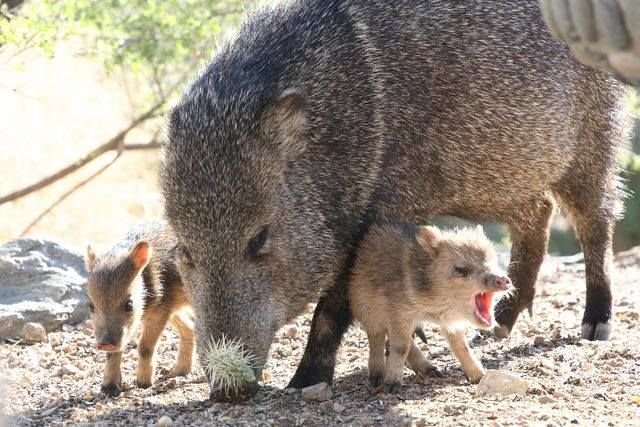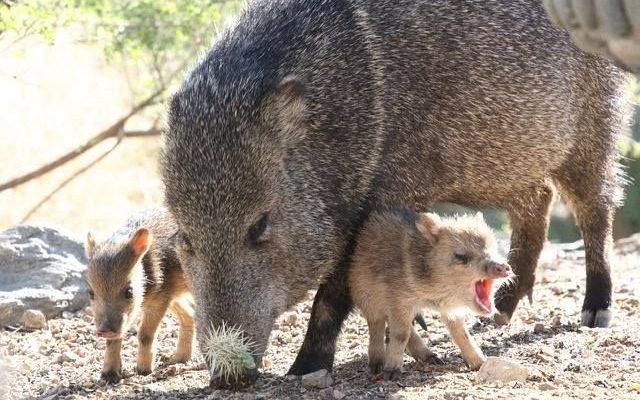
Let’s dig into this question, shall we? Picture a bustling family gathering at a picnic. You have a few javelinas quietly nibbling on some grass nearby, completely unbothered by the chaos. But then, consider this: their habitat is changing. As we chat about this, let’s explore the current conservation status of javelinas, what threatens them, and what we can do to support their existence in our world.
What Are Javelinas?
Javelinas are fascinating animals that can be found primarily in the southwestern U.S., Central America, and parts of South America. While they often get confused with pigs, they actually belong to the family Tayassuidae, which is different from true pigs (Suidae). Javelinas are usually about the size of a medium dog, with sturdy bodies, short legs, and a distinctive collar of white fur around their necks.
These creatures are social and typically live in small groups called sounders. With their sharp sense of smell and excellent hearing, they forage for food, primarily eating plants, fruits, and even small animals if the opportunity arises. Their presence in the ecosystem is essential, as they help with seed dispersal and maintaining the health of their habitat. But with all this in mind, are they facing any serious threats?
The Current Conservation Status
As of now, javelinas aren’t classified as endangered on a global scale. According to the IUCN Red List, they hold a status of “Least Concern,” which means they are relatively stable in numbers. However, that doesn’t mean they’re entirely free from threats. They face challenges primarily from habitat loss due to urban development, agriculture, and climate change.
Javelinas thrive in desert and scrub environments, but as human populations expand, their habitats shrink. This creates conflicts, especially when they wander into suburban areas in search of food. Here’s the thing: as their natural homes disappear, they must adapt to a world where they encounter humans more frequently. This increased interaction can lead to misunderstandings and even wildlife management efforts that can hurt their populations.
What Threatens Javelinas?
Javelinas are resilient creatures, but they do encounter various threats that can impact their survival. Some of the most pressing issues include:
- Habitat Loss: Urban development and agriculture are significant contributors to habitat fragmentation. As these areas expand, javelinas find it harder to locate food and shelter.
- Climate Change: Changes in weather patterns can affect the availability of water and food sources, impacting their health and reproduction rates.
- Human Interaction: As javelinas venture into suburban areas, they may be seen as pests. This can lead to negative encounters with people, often resulting in harm to the animals.
Each of these threats can contribute to a decline in javelina populations, even if they’re considered plentiful in some areas. Addressing these concerns is crucial if we want to see these unique animals continue thriving in the wild.
Conservation Efforts and Their Impact
Thanks to ongoing conservation efforts, javelinas are receiving the attention they need to maintain stable populations. Organizations and wildlife agencies are working together to create and enforce policies that protect their habitats. Here are some impactful strategies:
- Habitat Restoration: Efforts to restore natural habitats can help javelinas regain their home territory. Replanting native vegetation and removing barriers can make a significant difference.
- Public Education: Teaching people about javelinas and their roles in the ecosystem can foster coexistence. When communities understand these animals better, they’re more likely to support their conservation.
- Research and Monitoring: Ongoing research on javelina populations helps scientists understand their behavior, habitat needs, and responses to environmental changes. This information is vital for effective management plans.
By combining these strategies, we can help ensure that javelinas continue to roam freely. It’s essential to remember that even though they aren’t currently endangered, proactive measures can prevent future declines.
How You Can Help
Want to play a part in protecting javelinas? Here’s how you can help:
- Support Conservation Organizations: Donating to wildlife conservation groups can provide funding for projects focused on habitat restoration and education efforts.
- Spread Awareness: Talking to friends and family about javelinas and their importance in the ecosystem can foster a community that values wildlife preservation.
- Practice Responsible Wildlife Viewing: If you encounter javelinas in the wild, observe them from a distance. Respect their space to reduce stress on these animals and help promote a healthy relationship between humans and wildlife.
Even small actions can have a big impact on conservation efforts!
Final Thoughts on Javelina Conservation
To wrap it up, while javelinas aren’t currently endangered, the threats they face shouldn’t be ignored. Their future is in our hands, and by supporting conservation efforts and educating ourselves and others, we can help ensure these unique animals continue to thrive. Remember, each javelina plays a role in our ecosystem, and preserving their existence enriches our environment as a whole.
So, next time you’re out in the Southwestern deserts, keep an eye out for these remarkable creatures. Their quirky charm won’t just brighten your day; it’ll also remind you of the importance of protecting our wildlife.

